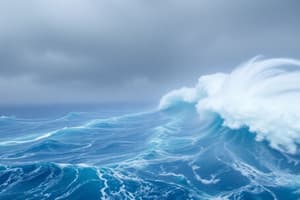Podcast
Questions and Answers
What primarily contributes to the formation of a typhoon?
What primarily contributes to the formation of a typhoon?
- High-pressure systems converging over land
- Warm, moist air evaporating off the ocean (correct)
- Cold air rising rapidly from ocean surfaces
- Land surfaces cooling the surrounding atmosphere
Which characteristic describes the winds around a typhoon's eye?
Which characteristic describes the winds around a typhoon's eye?
- The winds vary randomly without a specific movement pattern
- The winds are strongest near the eye's wall (correct)
- The winds are calm and non-rotating
- The winds move in a spiraling outward motion
Which statement is true about the relationship between typhoons and their geographical location?
Which statement is true about the relationship between typhoons and their geographical location?
- Typhoons are only located in coastal areas.
- Typhoons are common in areas near the Intertropical Convergence Zone. (correct)
- Typhoons can be generated in areas with cold ocean currents.
- Typhoons do not form in the equatorial regions.
How does the size of a cyclone's eye typically vary?
How does the size of a cyclone's eye typically vary?
What is a common consequence of a typhoon striking an area?
What is a common consequence of a typhoon striking an area?
What is the minimum ocean water temperature required for a tropical cyclone to develop?
What is the minimum ocean water temperature required for a tropical cyclone to develop?
Which category does a storm belong to when its wind speed reaches between 62 and 88 kph?
Which category does a storm belong to when its wind speed reaches between 62 and 88 kph?
What defines a super typhoon in terms of wind speed?
What defines a super typhoon in terms of wind speed?
In which region is the term 'typhoon' specifically used?
In which region is the term 'typhoon' specifically used?
What occurs as winds collect moisture and rise in a tropical cyclone?
What occurs as winds collect moisture and rise in a tropical cyclone?
Flashcards are hidden until you start studying
Study Notes
Location
- The Philippines is located in the Pacific typhoon belt.
- The Intertropical Convergence Zone (ITCZ) is a zone of convergence for trade winds where typhoons often form.
What is a Typhoon?
- A typhoon is a rotating storm that brings wind, rain, and destruction.
- Typhoons are also known as "bagyo" in the Philippines.
- Typhoons, hurricanes, and cyclones are all types of tropical cyclones.
Effects of a Typhoon
- Typhoons cause rain, strong winds, and damage to certain areas.
- Winds rotate around a central area.
Formation of a Typhoon
- Typhoons form over warm ocean waters.
- Warm, moist air rises, creating a low-pressure area.
- The warmer the air and moisture, the more intense the winds.
- Colder air moves in below, creating pressure that pushes the winds to move quickly.
- Typhoons typically occur between June and November.
Characteristics of a Typhoon
- The center of a typhoon is called the "eye".
- The eye of a typhoon ranges from 3 to 320 kilometers across.
- The average diameter of a typhoon's eye is 50 kilometers.
- Winds around the eye are the strongest, while winds inside the eye are weakest.
Tropical Cyclone Categories
- Each typhoon category corresponds to a specific wind speed.
- A storm becomes a typhoon when wind speed reaches 74 miles per hour.
- Tropical depressions have wind speeds between 33 and 61 kph.
- Tropical storms have wind speeds between 62 and 88 kph.
- Severe tropical storms have wind speeds between 89 and 117 kph.
- Typhoons have wind speeds between 118 and 200 kph.
- Super typhoons have wind speeds greater than 220 kph.
Typhoons vs. Hurricanes
- The term typhoon is used in the northwestern Pacific Ocean.
- In the northeastern Pacific Ocean and the northern Atlantic Ocean, the equivalent term is hurricane.
- In the Philippines, the term "typhoon" is used for all categories of tropical cyclones.
Studying That Suits You
Use AI to generate personalized quizzes and flashcards to suit your learning preferences.




